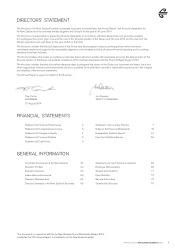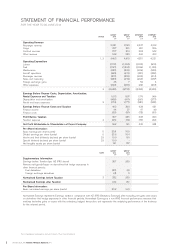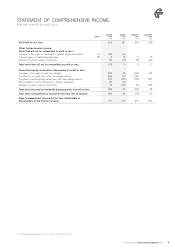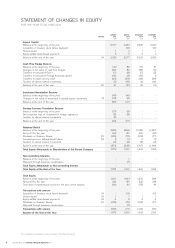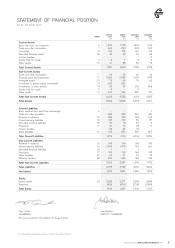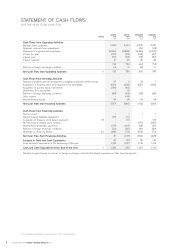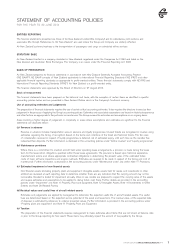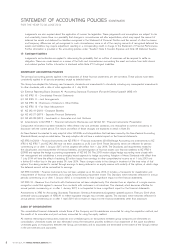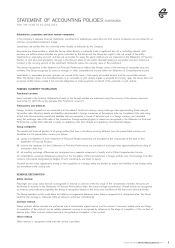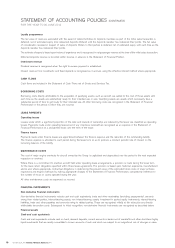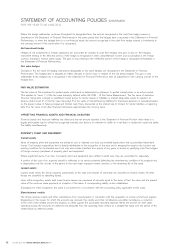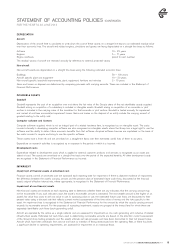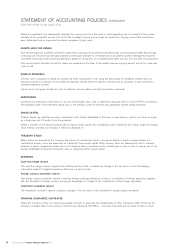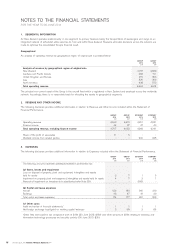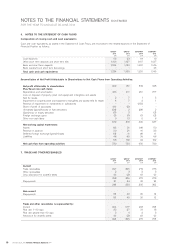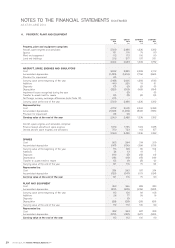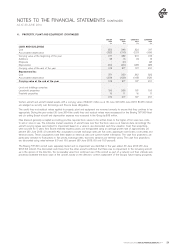Air New Zealand 2014 Annual Report Download - page 13
Download and view the complete annual report
Please find page 13 of the 2014 Air New Zealand annual report below. You can navigate through the pages in the report by either clicking on the pages listed below, or by using the keyword search tool below to find specific information within the annual report.
AIR NEW ZEALAND ANNUAL FINANCIAL RESULTS 2014 11
Trade and other receivables
Trade and other receivables are recognised at cost less any provision for impairment. A provision for impairment is established when
collection is considered to be doubtful. When a trade receivable is considered uncollectible, it is written-off against the provision.
Interest-bearing assets
Interest-bearing assets are measured at amortised cost using the effective interest method, less any impairment.
Non interest-bearing assets
Non interest-bearing assets are measured at amortised cost, less any impairment.
Investment in quoted equity instruments
Changes in the fair value of the investment in quoted equity instruments, including any related foreign exchange component, are recognised
through other comprehensive income where an irrevocable election has been made at inception to do so. This election is made in order
to ensure the appropriate representation of long-term, strategic investments as distinct from those held for trading. Dividends from such
investments are recognised in profit or loss when the right to receive payment has been established. The cumulative gains or losses held in
other comprehensive income are not transferred to profit or loss on derecognition or otherwise, although they may be transferred within equity.
Amounts owing from subsidiaries, joint ventures and associates
Amounts owing from related parties are recognised at cost less any provision for impairment. A provision for impairment is established
when collection is considered to be doubtful. When an amount owing from a related party is considered uncollectible, it is written-off
against the provision.
Financial liabilities
Interest-bearing liabilities
Borrowings and Bonds
Borrowings and Bonds are initially recognised at fair value, net of transaction costs incurred. They are subsequently stated at amortised
cost using the effective interest rate method, where appropriate. Borrowings and Bonds are classified as current liabilities unless the
Group has an unconditional right to defer settlement of the liability for more than 12 months after the balance date.
Finance leases
Finance lease obligations are initially stated at fair value, net of transaction costs incurred. The obligations are subsequently stated at
amortised cost.
Trade and other payables
Trade and other payables are stated at cost.
Amounts owing to subsidiaries, joint ventures and associates
Amounts owing to related parties are stated at cost.
Derivative financial instruments
Air New Zealand uses derivative financial instruments to manage its exposure to foreign exchange, fuel price, and interest rate risks
arising from operational, financing and investment activities. Equity derivatives are used to provide price protection in the event of a further
purchase of shares in Virgin Australia Holdings Limited. Derivative financial instruments are recognised initially at fair value and transaction
costs are expensed immediately. Subsequent to initial recognition, derivative financial instruments are recognised as described below:
Derivative financial instruments at fair value through profit or loss
Derivative financial instruments, other than those designated as hedging instruments in a qualifying cash flow hedge (refer below), are
classified as held for trading. Subsequent to initial recognition, derivative financial instruments in this category are stated at fair value.
The gain or loss on remeasurement to fair value is recognised immediately in the Statement of Financial Performance.
Hedge accounted financial instruments
Where financial instruments qualify for hedge accounting in accordance with NZ IAS 39 - Financial Instruments: Recognition and
Measurement, recognition of any resultant gain or loss depends on the nature of the hedging relationship, as detailed below.
Cash flow hedges
Changes in the fair value of hedging instruments designated as cash flow hedges are recognised within Other Comprehensive Income
and accumulated within equity to the extent that the hedges are deemed effective in accordance with NZ IAS 39 - Financial Instruments:
Recognition and Measurement. To the extent that the hedges are ineffective for accounting, changes in fair value are recognised in the
Statement of Financial Performance.
If a hedging instrument no longer meets the criteria for hedge accounting, expires or is sold, terminated or exercised, or the designation
of the hedge relationship is revoked or changed, then hedge accounting is discontinued. The cumulative gain or loss previously
recognised in the cash flow hedge reserve remains there until the forecast transaction occurs. If the underlying hedged transaction is no
longer expected to occur, the cumulative, unrealised gain or loss recognised in the cash flow hedge reserve with respect to the hedging
instrument is recognised immediately in the Statement of Financial Performance.
STATEMENT OF ACCOUNTING POLICIES (CONTINUED)
FOR THE YEAR TO 30 JUNE 2014


